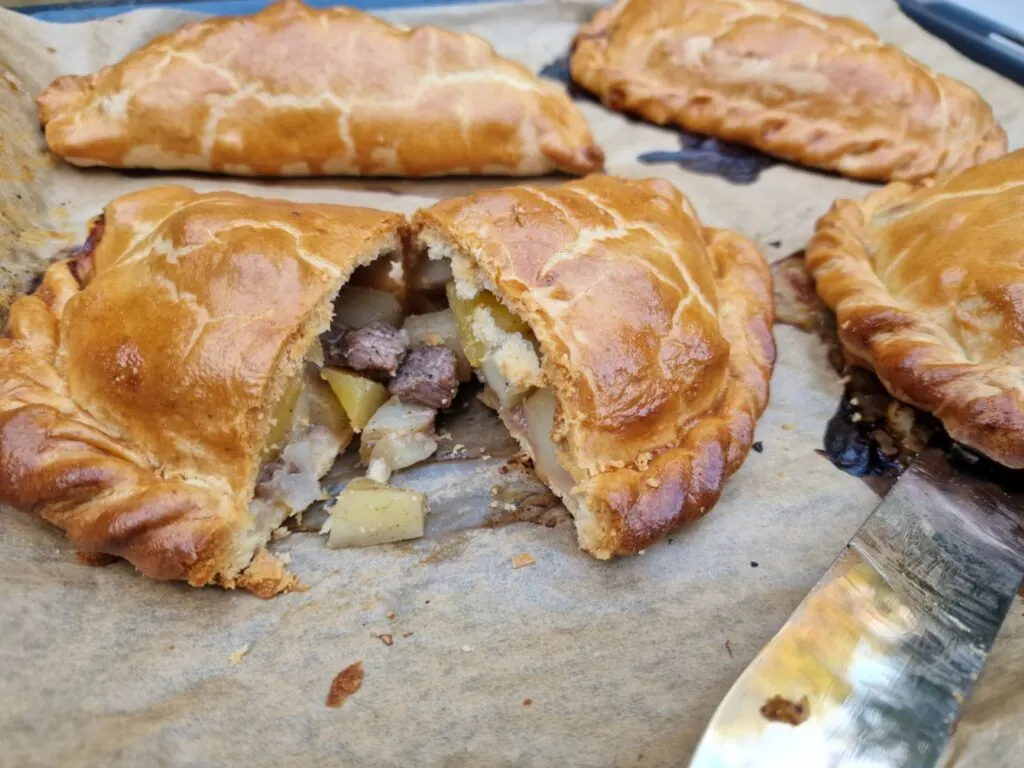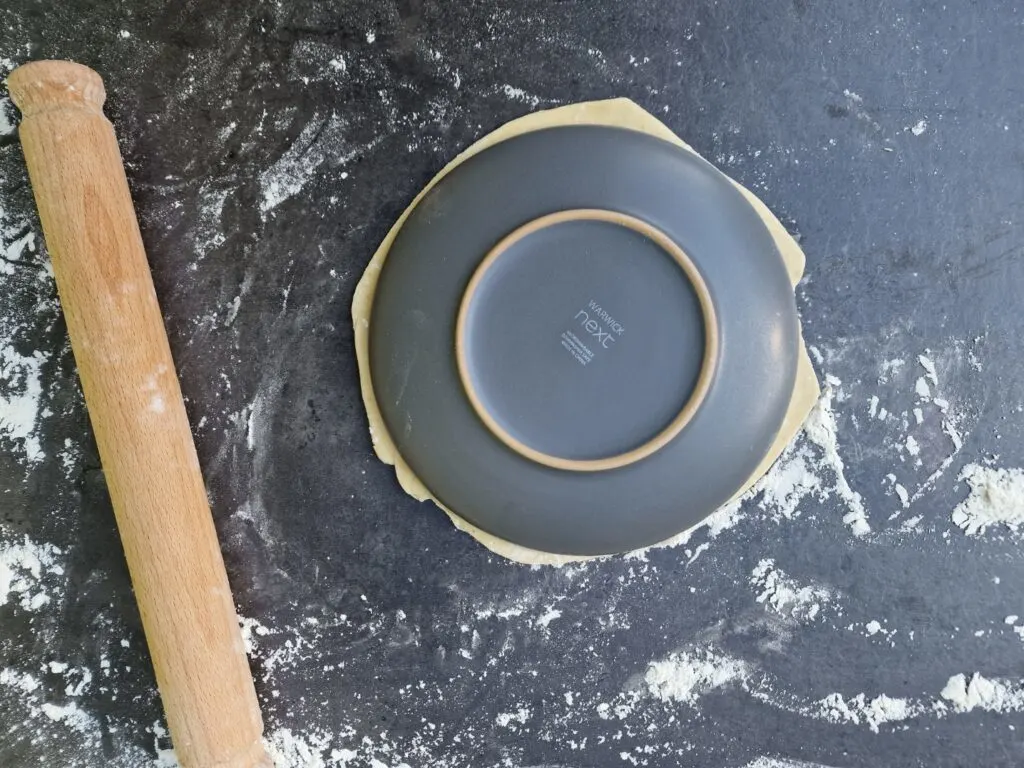Follow this easy to make Cornish Pasty recipe – delicious meat and vegetables wrapped in a golden pastry – an iconic British recipe.

Cornish Pasty History
Cornwall’s most iconic food, the Cornish Pasty, first became very popular with Cornish tin miners as it was an affordable all-in-one lunch.
The shape was easy to carry, and supposedly the crimped edge would serve as a pasty handle for the miners, who didn’t have time to surface and wash their hands.
What’s In A Cornish Pasty?
Although the recipe may vary slightly between different bakeries and families, a Cornish Pasty contains flour, cold lard, cold butter, water, beef, swede, potato, onion, salt, pepper, and egg/milk (for glaze).
How To Make Cornish Pasties – Step By Step
First, start by making the pastry. The key to a good pastry is to keep the dough as cold as possible by using ice-cold water and keeping work on the mixture to a minimum.
I used a food processor to do this, but you can also do this by hand by mixing in the butter and lard between your fingers until the mixture resembles breadcrumbs.

Mix the flour and salt with the butter and lard until it resembles breadcrumbs.

Add ice-cold water and bring together into a rough dough.

Wrap in cling film, shape into a disc about an inch thick and place in the fridge for an hour (the disc shape will make it cool faster).
Prepare the filling by dicing the beef skirt, potatoes, swede and onion into small chunks. Mix together in a large bowl with the salt and pepper until everything is evenly mixed and coated.
Place the dough onto a floured surface. Divide into six, and take one piece to work on, returning the other five to the fridge.

Preheat oven to 170°C/Gas Mark 5.
Roll out into a medium circle with a rolling pin, about 20cm in diameter. A side plate makes a good size guide for this. Brush off any excess flour.

Place a large spoonful of filling in the centre and fold it in half. Use the side of your hand to squeeze the curved edge shut.


Crimp the edge shut by pushing the edge with your left index finger and then twisting the dough over your right thumb and pressing it into the pastry edge.
This took me a pasty or two to get the hang of it, so don’t worry if you find it difficult. Try not to tear the dough, and fix any holes that appear, so the filling doesn’t dry out.


Repeat for the remaining pasties. Brush with beaten egg and bake for 45 minutes until evenly golden brown.

Can You Freeze Cornish Pasties?
Yes, you can, both before and after baking.
To freeze after baking, allow to completely cool, then place in a sealed bag and freeze for up to 6 months.
To freeze before baking, freeze on a tray, so the pasties don’t stick together. When frozen, place all the pasties in a sealed bag or container for storage.
You can cook from frozen; simply cook for an extra 15 minutes.
How To Reheat Cornish Pasties
Reheat in the oven for 15 minutes at 170°C/Gas Mark 5

Cornish Pasties
If you've ever visited Cornwall, you will almost certainly have tried a Cornish pasty. The key to a light, crisp pastry is to keep it as cold as possible, so if possible, use a food processor and ice-cold water in the pastry.
Ingredients
For the pastry
- 500g strong white bread flour
- 1tsp salt
- 150g cold butter
- 100g cold lard
- 170ml ice cold water
For the filling
- 450g beef skirt (or standard diced beef if unavailable)
- 450g new potatoes
- 225g swede
- 1 large onion, about 200g
- 2tsp salt
- 1tsp black pepper
- 1 egg, beaten
Instructions
- For the best result, use a food processor. Mix the flour and salt together.
- Rub the butter and lard into the flour until the mixture resembles breadcrumbs. Do not over-mix, as we want the fats to stay as cold as possible.
- Mix in 170ml ice cold water and bring together into a dough. wrap in cling film and shape into a flat disc about an inch thick, and place in the fridge for at least an hour to chill.
- Prepare the filling by peeling and finely dicing the swede, onion and new potatoes (no need to peel). Add to a large mixing bowl. Chopping the pieces smaller will mean they will cook quicker, and the pasties will be easier to close. Add the finely diced beef to the bowl.
- Add 2tsp salt and 1tsp black pepper, and thoroughly mix until everything is well combined and evenly coated in salt and pepper.
- Preheat the oven to 170°C/Gas Mark 5
- Divide the pastry into six even-sized pieces. Place one on a floured surface, keeping the others in the fridge while you work. Roll out into a circle using a rolling pin, about half a centimetre thick. A side plate is a good guide for consistent size.
- Spoon one or two spoonfuls of filling into the middle of the pastry (about one-sixth of the mixture), making sure to leave at least 2cm around the edge of the circle to seal the pasty. Fold one half over, and squeeze the edges shut with the side of your hand.
- Crimp the edge shut by repeatedly twisting and pressing the edge of the pastry shut- this is quite difficult, and the first pasty may not look the best. Try to seal the pastry if there are any tears so the filling doesn't dry out.
- Store completed pasties in the fridge while you work on the others.
- Place the completed pasties on baking paper, on baking trays and brush with beaten egg.
- Bake for 50 minutes, by when the pasties should be golden brown and slightly shiny.
Nutrition Information:
Yield: 4 Serving Size: 1Amount Per Serving: Calories: 1404Total Fat: 78gSaturated Fat: 37gTrans Fat: 2gUnsaturated Fat: 34gCholesterol: 249mgSodium: 2085mgCarbohydrates: 125gFiber: 8gSugar: 7gProtein: 50g
